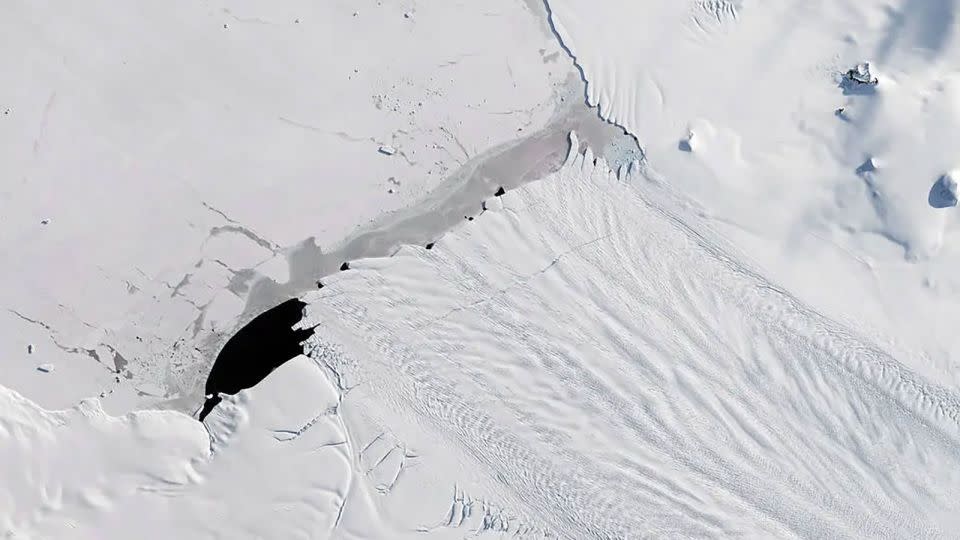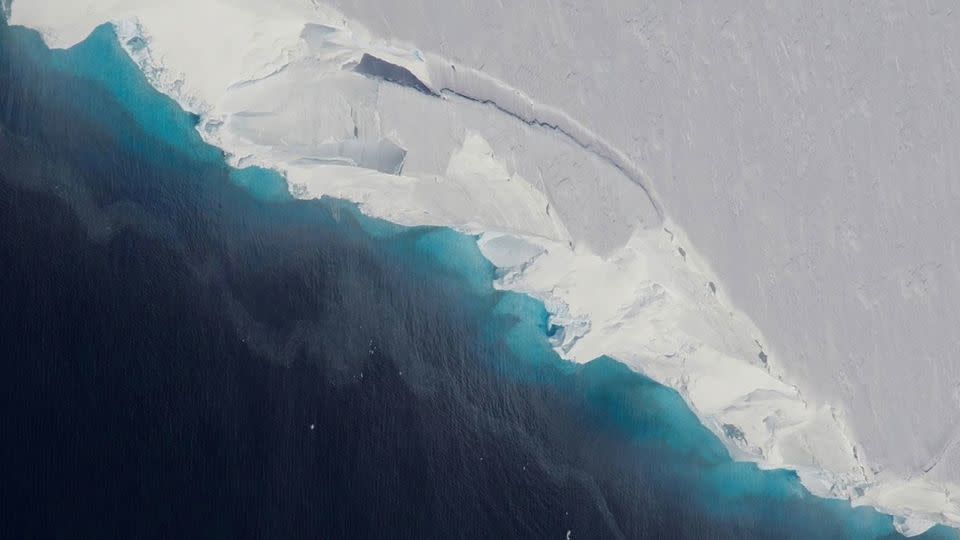Scientists have looked back in time to recreate the life of Antarctica’s “Doomsday Glacier” – nicknamed because its collapse could lead to catastrophic sea level rise. They found that it began to retreat rapidly in the 1940s, according to a new study that provides an alarming picture of future melting.
The Thwaites Glacier in West Antarctica is the widest in the world and about the size of Florida. Scientists knew that ice was being lost at an accelerating rate since the 1970s, but because satellite data only goes back a few years, they didn’t know exactly when significant melting began.
Now there is an answer to this question, according to a study published Monday in the journal Proceedings of the National Academy of Sciences.
By analyzing marine sediment cores taken from beneath the ocean floor, the researchers found that the glacier began to retreat significantly in the 1940s, triggering a very strong El Niño event — a natural climate fluctuation that it usually has a warming effect.
Since then, the glacier has failed to recover, which may reflect the increased impact of human-caused global warming, according to the report.
What happens to Thwaites will have global reverberations. The glacier already contributes 4% to sea level rise as it dumps billions of tonnes of ice a year into the ocean. Its total collapse could raise sea levels by more than 2 feet.
But it also plays a vital role in the stability of the West Antarctic Ice Sheet, acting like a cork that holds the vast stretch of ice behind it. Thwaites’ collapse would undermine the stability of the ice sheet, which holds enough water to raise sea levels by at least 10 feet, causing catastrophic global flooding.

The study’s findings are consistent with previous research on the nearby Pine Island Glacier, one of Antarctica’s largest ice streams, which scientists also found began to retreat rapidly in the 1940s.
This makes the research significant, said Julia Wellner, associate professor of geology at the University of Houston and one of the authors of the study. What is happening to Thwaites is not specific to any one glacier, but part of the larger context of a changing climate, she told CNN.
“If both glaciers are retreating at the same time, that’s further evidence that they’re really being forced by something,” Wellner said.
To build a picture of Thwaites’ life over the past nearly 12,000 years, scientists took an icebreaker near the edge of the glacier to collect ocean sediment cores from a range of depths.
These cores provide a historical timeline. Each layer provides information about the ocean and ice going back thousands of years. By scanning and dating the sediments, the scientists were able to determine when the substantial melting began.
From this information, they believe that the Thwaites retreat was strongly driven by El Niño which occurred at a time when the glacier was probably already in a melting phase, tipping the balance. “It’s like if you get kicked when you’re already sick, it’s going to have a much bigger impact,” Wellner said.
The results are alarming because they suggest that it is very difficult to stop them once large changes are made, said James Smith, a marine geologist at the British Antarctic Survey and co-author of the study.
“Once an ice sheet retreat is set in motion it can continue for years, even if what it started doesn’t get worse,” he told CNN.
Although similar retreats occurred much further in the past, the ice sheet recovered and recovered, Smith said. But these glaciers show no signs of recovery, reflecting the increasing impact of human-caused climate change.


Ted Scambos, a glaciologist at the University of Colorado Boulder who was not involved in the research, said the study confirms and adds detail to our understanding of how the Thwaites retreat began.
A system that was already close to unstable “took a big shot out of a mostly natural event,” Scambos said, referring to the El Niño. “Other events that resulted more from the warming climate trend pushed things further, and started the widespread recession we’re seeing today,” he told CNN.
Martin Truffer, a professor of physics at the University of Alaska Fairbanks, said the research shows that if a glacier is in a fragile state, “one event could knock it into a retreat from which it is difficult to recover.”
“Humans are changing the climate and this study shows that small, continuous changes in the climate can make big changes in the state of the glacier,” said Truffer, who was not involved in the research.
Antarctica is sometimes called the “sleeping giant” because scientists are still trying to understand how vulnerable this icy, remote continent can be as humans heat the atmosphere and oceans.
Wellner is a geologist — she focuses on the past, not the future — but she said this study provides important and alarming context for what could happen to the ice in this critical stretch of Antarctica.
It shows that even if a fast melting trigger has stopped, that doesn’t mean the reaction stops. “So if the ice is already retreating today,” she said, “just because we could stop the warming, it might not stop retreating.”
For more CNN news and newsletters create an account at CNN.com